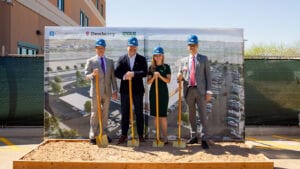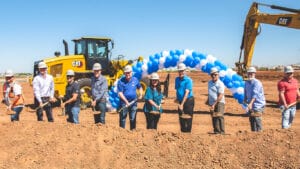While experts express conflicting predictions regarding the national commercial real estate landscape moving into 2019, what can we expect on our own turf? While the opportunity for growth continues to be favorable for the Valley in many aspects, the local 2019 commercial real estate outlook may be met without a few challenges. Who better to explain the delicate balance of Arizona’s impending commercial real estate trends, than the CFMA Valley of the Sun Chapter, Construction Executive of the Year, Casey Cartier, president and CEO of Jokake Construction.
Jokake’s industry reach extends over much of the Southwest, California and Colorado, covering healthcare, education, the public sector, retail and industrial markets. In his six years as president and CEO, Cartier has been witness to the push and pull that has exemplified the local commercial real estate market over the past few years. While new builds and renovations flourish in certain areas of the Valley, the steep inflation in construction cost and a shortage of labor are proving to be formidable obstacles.

Taking a look at the ‘push
Cartier expects 2019 to present a positive push for the manufacturing and industrial sector, alongside micro healthcare, particularly in the West Valley and Mesa.
“The bulk of the work we’re seeing through Jokake centers within the industrial market,” Cartier explains. “And while individual new-build manufacturing projects are typically smaller in scale, they’re increasing in quantity, particularly in suburban areas.”
Jokake’s ongoing relationship with Carvana rehabilitation center serves as a perfect example. The construction project located in Tolleson includes five buildings that serve as a centralized hub for maintenance, body paint, automated photo booth and administrative office space for Carvana’s unique new-car vending machines.
In addition to suburban areas, expect to see pockets of manufacturing installations nestled in tech corridors, several of which will be located in or around Phoenix-Mesa Gateway Airport.
“We’re also going to witness more micro-hospital development in rural areas,” Cartier says. “We have plans for a 15,000-square-foot facility in Gilbert, among other similarly scaled projects.”
Abrazo is one primary paradigm of the micro-hospital boom, with several locations popping up from Buckeye to Mesa that have either been recently completed and slated for completion in 2019.
Another area the commercial real estate industry can expect to observe impressive economic growth in is the tourism sector.
“With another Super Bowl in our future and continuous renovations in local resorts and hospitality offerings, we will no doubt see more dollars being contributed to the tourism industry,” Cartier says.
On a macro scale, Cartier points to a particularly exciting and potentially prosperous aspect of commercial real estate.
“There’s a possible opportunity for Arizona to become a gateway for products going into Mexico,” Cartier says. “As Mexico gains economic strength, Arizona could serve as the main point for jobs and businesses.”
Examining the ‘pull’ and where it will lead
While the push toward positive growth and opportunity remains positive, the pull within the commercial real estate industry may present challenges.
“Right now, we are looking at two major areas of concern,” Cartier says. “Construction prices have increased month over month and are now outpacing rents on the other side of commercial real estate, creating a significant imbalance.”
Both commodity prices and transportation fees have continued to increase across the board for the 20th straight month, according to Cartier.
The result of this disproportion, perhaps not surprisingly, has placed commercial real estate leaders in a state of limbo.
“At this point, no one knows the potential for tariffs or a trade war,” Cartier says.
And, while commercial real estate decision-makers remain watchful for further potential strife, they are still dealing with skilled labor shortages.
“There’s an increased need for skilled labor for highly technical-based projects,” Cartier says. “We’re really seeing how the labor shortage is affecting schedule demands. We’re not getting the large crews we used to, which naturally impacts schedules, and I think this pattern will only continue.”
Silver linings
Despite the lurking roadblocks, Cartier remains optimistic and solution-oriented in his overall outlook.
“The real exciting piece we’ve been investing in for the past two years at Jokake regarding labor shortages as they relate to commercial real estate construction has been adopting a manufacturing mindset,” Cartier says. “A prefab, technological mindset is required. Labor shortages and quality concerns demand that we operate as a paperless site and team. We’ve reached a time when logistics software and virtual reality will replace tape measure and hammer.”
Cartier also highlights the advantage of residential and commercial camaraderie supported by cooperative municipalities and local leadership.
“The cities are working together to parcel out where new businesses will plant,” he says. “The larger home builders in the West Valley, for example, will help necessitate the need for new employment options in close proximity. Single-family construction will spur commercial businesses and job opportunities to those areas rather than being centralized like they have been in the past.”
Looking ahead
Byron R. Carney, market leader, Cushman & Wakefield: “The Phoenix commercial and industrial real estate markets remain strong and should grow stronger in 2019. The improvements are fueled by steady middle-income job growth, disciplined office and industrial development and nation-leading population growth.”
Dave Cheatham, president, Velocity Retail Group: “Phoenix is ranked high in all major economic indicators. This coupled with continued employment growth should springboard retail real estate to a stronger year. This will show in lower vacancy, increased leasing activity and interest from new tenants not yet in our market.”
Sharon Harper, chairman, president and CEO, Plaza Companies: “Our specific sectors of healthcare, bioscience, technology and our focus on unique commercial office will thrive and flourish in 2019 due to the foundational factors supporting growth in these markets. Those include strong demographics, innovation, public-private and university partnerships and great leadership in the State of Arizona.”
K. Michelle Lind, CEO, Arizona Association of Realtors: “Arizona’s population continues to grow and more millennials are entering into the market. Buyers and sellers continue to recognize the value of a Realtor to provide reliable information on homes and neighborhoods and assist in the complexities of the buying and selling process.”
Bob Mulhern, senior managing director, Colliers International: “We have a lot of confidence in all sectors of commercial real estate for 2019. We are blessed to have a strong economy deep into this recovery, and we encourage everyone to take full advantage of it.”




